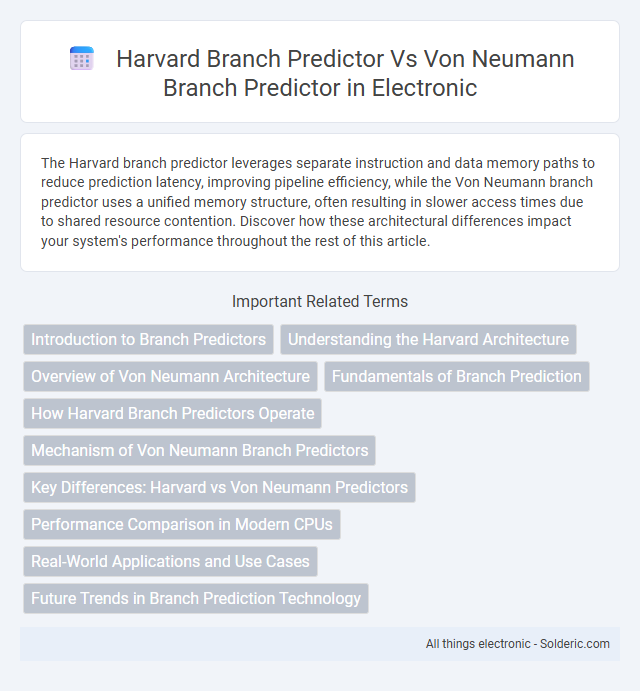The Harvard branch predictor leverages separate instruction and data memory paths to reduce prediction latency, improving pipeline efficiency, while the Von Neumann branch predictor uses a unified memory structure, often resulting in slower access times due to shared resource contention. Discover how these architectural differences impact your system's performance throughout the rest of this article.
Comparison Table
| Feature | Harvard Branch Predictor | Von Neumann Branch Predictor |
|---|---|---|
| Architecture | Separate instruction and data caches | Unified instruction and data cache |
| Prediction Mechanism | Uses distinct caches for faster, parallel access | Shared cache leads to sequential access and potential delays |
| Speed | Higher due to cache separation reducing bottlenecks | Lower because of cache contention |
| Complexity | More complex hardware design | Simpler design with shared resources |
| Accuracy | Generally higher due to specialized prediction units | Lower due to potential cache conflicts |
| Use Cases | High-performance CPUs demanding low latency | Cost-sensitive and simpler CPU designs |
Introduction to Branch Predictors
Branch predictors improve CPU performance by guessing the direction of conditional branches, minimizing pipeline stalls. The Harvard branch predictor leverages separate instruction and data memories to optimize prediction accuracy and speed, while the Von Neumann branch predictor operates with a unified memory architecture, often resulting in slower access but simpler design. Both architectures aim to enhance instruction-level parallelism by effectively managing control flow changes during program execution.
Understanding the Harvard Architecture
Harvard branch predictors leverage separate instruction and data pathways inherent in the Harvard architecture to enable faster and more accurate prediction of control flow changes compared to the Von Neumann branch predictor, which operates within a unified memory structure. The distinct separation in Harvard architecture reduces pipeline hazards and memory access conflicts, enhancing instruction fetch efficiency during speculative execution. Understanding this architectural difference helps you optimize processor designs for improved branch prediction accuracy and overall performance.
Overview of Von Neumann Architecture
The Von Neumann architecture relies on a single memory space for both instructions and data, which causes the classic bottleneck affecting execution speed. Von Neumann branch predictors operate within this unified memory framework, often limiting prediction accuracy due to sequential instruction fetching constraints. In contrast, Harvard branch predictors benefit from separate instruction and data memories, enabling faster and more accurate branch prediction by allowing simultaneous access and reducing latency.
Fundamentals of Branch Prediction
The Harvard branch predictor leverages separate instruction and data caches to reduce pipeline stalls by accurately forecasting branches using distinct data pathways, improving CPU efficiency. In contrast, the Von Neumann branch predictor operates within a unified memory architecture, relying on historical execution patterns stored in a single cache, which can introduce latency due to resource contention. Your understanding of branch prediction fundamentals highlights how architectural differences influence prediction accuracy and processor performance.
How Harvard Branch Predictors Operate
Harvard branch predictors operate by utilizing separate instruction and data caches to efficiently fetch and predict branch outcomes, reducing latency and improving pipeline performance. Unlike the Von Neumann branch predictor, which accesses a unified memory for both instructions and data, the Harvard architecture enables parallelism by allowing simultaneous instruction fetch and prediction processes. Your processor benefits from faster branch resolution and minimized pipeline stalls due to this separation of memory pathways.
Mechanism of Von Neumann Branch Predictors
Von Neumann branch predictors operate by using a single unified memory for both instructions and data, leading to a simpler but slower prediction mechanism compared to Harvard branch predictors, which utilize separate instruction and data caches. The Von Neumann approach fetches branch instructions sequentially and relies on historical branch outcomes stored in a global history table to predict the direction of branches. This mechanism can cause pipeline stalls due to instruction and data memory contention, limiting prediction accuracy and performance in complex modern processors.
Key Differences: Harvard vs Von Neumann Predictors
Harvard branch predictors separate instruction and data caches, enabling parallel access and reducing pipeline stalls, while Von Neumann predictors use a unified cache leading to potential contention and slower prediction rates. Harvard predictors often implement more specialized and faster prediction algorithms leveraging distinct data paths, whereas Von Neumann predictors handle both instructions and data through a single bus, impacting prediction speed and accuracy. This architectural distinction results in Harvard predictors typically offering higher throughput and lower latency compared to Von Neumann branch predictors.
Performance Comparison in Modern CPUs
Harvard branch predictors leverage separate instruction and data caches to minimize pipeline stalls, resulting in faster branch prediction and improved instruction throughput compared to Von Neumann predictors that share a unified memory, often causing contention and latency. Modern CPUs favor Harvard predictors for their ability to reduce misprediction penalties through parallelism and enhanced prediction accuracy using dedicated tables and buffers. Your application's performance benefits significantly from the Harvard design's advanced speculation techniques, which maintain higher instruction-level parallelism in today's complex processor architectures.
Real-World Applications and Use Cases
Harvard branch predictors are predominantly utilized in high-performance embedded systems and digital signal processors where separate instruction and data caches optimize parallelism and pipeline efficiency. Von Neumann branch predictors find application in general-purpose CPUs and older computing systems that rely on a unified memory architecture, balancing simplicity with effective control flow prediction. Your choice between these predictors impacts the performance and efficiency of specific applications, such as real-time processing versus general computing workloads.
Future Trends in Branch Prediction Technology
Future trends in branch prediction technology emphasize enhanced accuracy through machine learning integration, surpassing traditional Von Neumann predictors' static heuristics. Harvard branch predictors exploit separate instruction and data caches to enable parallelism and reduce latency, driving innovation in hybrid models that combine dynamic prediction with neural networks. Continued advancements target minimizing misprediction penalties in high-performance processors by leveraging adaptive algorithms and large-scale pattern recognition.
Harvard branch predictor vs Von Neumann branch predictor Infographic

 solderic.com
solderic.com